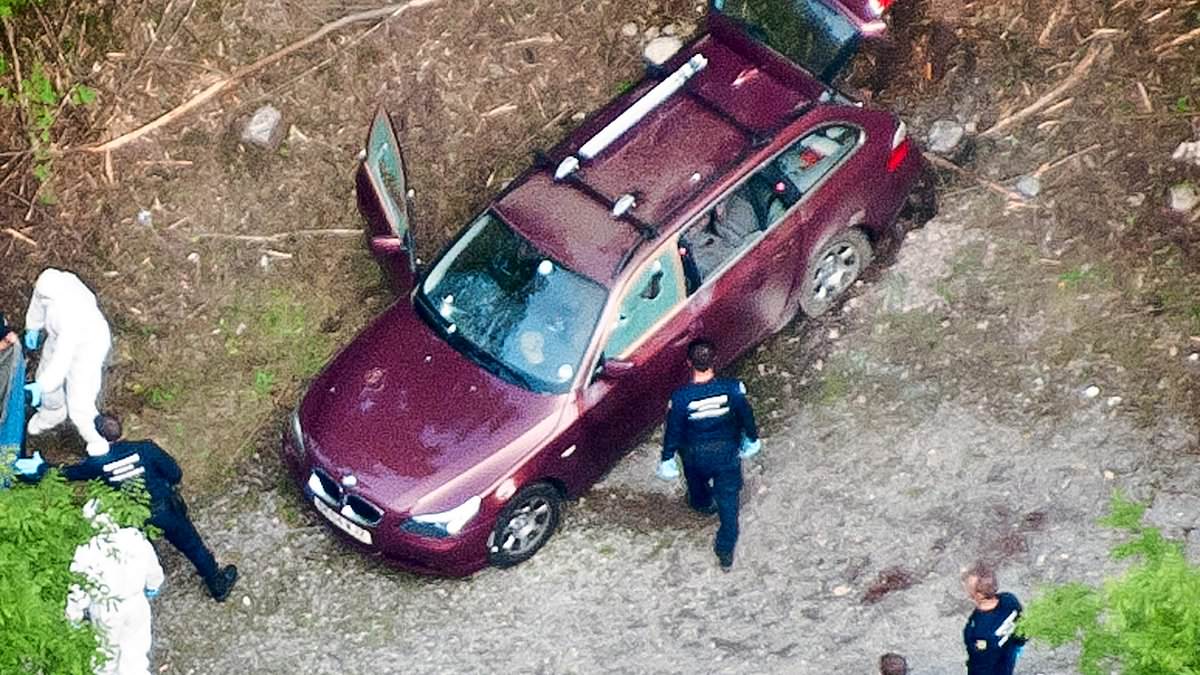French investigators believe the brutal mass shooting of three British family members and a French cyclist in the Alps could finally be solved after 12 years – as a new lead suggests the murderer was a special forces soldier who ‘went off the rails’.
Saad Al-Hilli, 50, an Iraq-born satellite engineer from Surrey, was shot dead at the wheel of his BMW on a remote mountain road near Lake Annecy in 2012.
His wife Iqbal, 47, her mother Suhaila, 74, and local cyclist Sylvain Mollier, 45, were also executed in a hail of bullets during the incident, which sent shockwaves throughout Europe.
Saad’s eldest daughter Zainab, seven, was left critically injured after being shot in the shoulder and pistol-whipped, while her four-year-old sister Zeena miraculously survived by cowering under her mother’s lifeless body for hours.
Now a Paris cold case unit has reopened the investigation with experts especially interested in the theory the murders were carried out by ‘a seasoned former soldier, trained in very particular shooting techniques’ by Swiss special forces, who had ‘gone off the rails’, Le Parisien reported.
Analysts point to a number of pieces of evidence, including that within just 60 to 90 seconds the perpetrator had fired 21 shots.
The three tragic members of the Al-Hilli family were each hit three or four times, while cyclist Mr Mollier, who was passing by on the road at the time, was fired at six times.
Of all the shots, 18 hit their targets, suggesting a perpetrator with ‘extreme composure and great skill in handling a weapon’.
The type of weapon used – a Luger PO6 – is also not favoured by professional hitmen, as they are known to regularly malfunction and are considered unreliable.
It is believed that the killer’s gun did jam explaining why Zainab was struck in her head with the butt of a weapon after being hit in the shoulder.
According to the expert, there is also interest around the perpetrator choosing to finish off his victims by shooting at very close range – a technique used in specialised military training, but particularly by the Swiss Détachement d’Action Rapide et de Dissuasion (DARD).
‘This is something learned in Switzerland, not in France, or the guy is part of a specialized unit,’ he told Le Parisien.
The latest lead comes nearly a month after Mr Al-Hilli’s brother Zaid, 65, accused French police of a ‘diabolical’ cover-up and negligence that hampered one of the most notorious unsolved cases of the century.
Zaid, who was once himself named as a suspect by French police but later cleared, said last month: ‘The initial investigation was a complete disaster. Look at the mistakes – were they accidental, or were they part of something bigger? That’s what we need to find out,’ he told The Mirror.
He slammed the original team for contaminating the crime scene, trampling over crucial evidence, and failing to conduct a reconstruction at the time of the murders.
Instead, a belated reconstruction took place more than a decade later at a disused airfield outside Paris, attended by lawyers and police chiefs.
‘It’s appalling that we’ve had to wait 11 years for them to piece this together,’ he added. ‘What else has been lost or destroyed in that time?,’ he added.
Prosecutors have admitted that a forensics officer accidentally contaminated key evidence with his own DNA, and that the area around the crime scene was inexplicably reopened to the public just 48 hours after the massacre.
The case has been plagued by speculation over possible motives, ranging from Saad’s high-security work in the satellite industry to family disputes over inheritance.
Zaid himself was arrested by UK police in 2013 on suspicion of conspiracy to murder, following reports of a feud between the brothers.
He was released six months later without charge.
Other theories have pointed to Sylvain Mollier as the intended target.
The local father-of-three was reportedly shot first and last, with more bullets than anyone else.
Former Surrey detective Mark Preston, who worked on the case, told a Channel 4 documentary that the Al-Hilli family may have been innocent bystanders caught in the crossfire of a targeted hit on Mollier.
The reopening of the case has brought fresh hope to Zaid and the families of the victims.
The inquiry is now being overseen by the Association for Victims of Unsolved Crimes, a new organisation led by ex-police chief Benoît de Maillard, which is reviewing 391 cold cases across France.
Zaid has also hired renowned French lawyer William Bourdon to push for answers, but has admitted his annoyance at the opportunities that had been missed in the early days of the investigation.
The original investigators’ failure to even locate Zeena for eight hours – despite her being alive and hidden under her mother’s corpse – has been widely criticised as emblematic of the botched handling of the case.
Zaid remains convinced that local authorities deliberately concealed key information.
‘This was a local crime, covered up by local police,’ he claimed.
‘After all this time, we deserve answers,’ he said. ‘We deserve to know why this happened – and why the police failed us so badly.’
